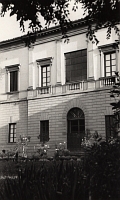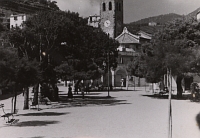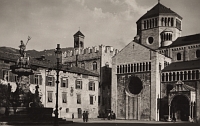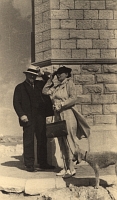Florence 1935-1943
1935
In October, Purrmann moves to Italy, assuming the administration of the Villa Romana in Florence, a foundation for German artists. The selection of Purrmann is a surprising one, since among the thirteen candidates are multiple National Socialists; what is more, the Ministry of Propaganda suggested a candidate of its own, the archaeologist Baron von Bissing. The chairman of the Villa Romana foundation is Hans-Alfons Simon, director of the Berliner Bank. The Villa Romana foundation, created in 1904 by Max Klinger and others, was established to help young German artists to spend a year in Florence. Purrmann would play a major role in the recreation of the Villa Romana foundation in 1958.
He maintains manifold contacts not only to the scholarship recipients but also to members of other German institutions, such as Dr. Hugo Max, director of the German School, which ultimately came to own a large collection of Purrmann’s paintings. He also has contacts at the Kunsthistorisches Institut, the German art historical institute in Florence; in September 1943, Purrmann would witness the tragic death of its director, Friedrich Kriegbaum, in a bombing raid. Other important contact persons are the art historians Herbert Siebenhüner and Theodor Hetzer. Siebenhüner and Purrmann share interests in the history of color in art. Purrmann related to Hetzer’s widow the influence that Hetzer and Hetzer’s writings had on him: “I know of no art historian who thought so independently, and who was so full of original ideas, as your husband. I turn to his books again and again, for they really immerse me in the artists. What I found particularly and tremendously pleasing was what he thought and said on surface in painting. I have found no remarks on composition as excellent as those in his book on the majesty of Dürer’s paintings, a book to which I often return.” (Göpel 1961, p. 265).
1936
Negotiations in the early months of the year regarding renovations of and additions to the Villa Romana: Purrmann instructs the conversion of the dilapidated orangery “Limonaia” into two garden studios, which will be badly damaged in the war. Purrmann writes to Brüne in January that he intends to exhibit at the Galerie Nierendorf in Berlin. He spends the summer months on the Ligurian coast in Monterosso and Lerici, painting a substantial number of watercolors.
1937
Purrmann is in Stuttgart for Christmas of 1936 and into 1937. Illness compels him to set aside his plans to travel to Munich. In the summer of 1937, he makes a study visit to Castiglioncello, where he focuses on watercolors.
Purrmann is officially deemed a “degenerate artist.” Thirty-six of his paintings and a larger number of graphic works are removed from public museums in Bremen, Munich, Kaiserslautern, Karls-ruhe, Cologne, Stettin, Breslau, and other cities, works that for the most part have yet to be located. Two of Purrmann’s paintings are included in the touring exhibition “Entartete Kunst”. The exhibition of his works is forbidden. These circumstances complicate his position in Florence. He is falsely accused of having been a member of the “Novembergruppe,” a group of revolutionary artists in 1919 and afterwards. To his great surprise, Purrmann is mentioned in Bruno Kroll’s book „Deutsche Künstler der Gegenwart“.
Purrmann is officially deemed a “degenerate artist.” Thirty-six of his paintings and a larger number of graphic works are removed from public museums in Bremen, Munich, Kaiserslautern, Karls-ruhe, Cologne, Stettin, Breslau, and other cities, works that for the most part have yet to be located. Two of Purrmann’s paintings are included in the touring exhibition “Entartete Kunst”. The exhibition of his works is forbidden. These circumstances complicate his position in Florence. He is falsely accused of having been a member of the “Novembergruppe,” a group of revolutionary artists in 1919 and afterwards. To his great surprise, Purrmann is mentioned in Bruno Kroll’s book „Deutsche Künstler der Gegenwart“.
1938
Hitler and Mussolini meet in Florence on May 9. Purrmann is taken into protective custody for some time, and is placed in the “Murate” prison. Purrmann is visited in this period by Theodor Heuss, the future Federal President of West Germany, whom he knows from his time in Paris.
In Siena, Purrmann runs into the painter Leo von König and his family. The artists grow closer and paint together in the Sienese countryside. In the same year, Purrmann paints in Lerici (near Genoa), and in Val Gardena in South Tyrol.
In Siena, Purrmann runs into the painter Leo von König and his family. The artists grow closer and paint together in the Sienese countryside. In the same year, Purrmann paints in Lerici (near Genoa), and in Val Gardena in South Tyrol.
1939
In the spring of 1939, the board of the Villa Romana votes unanimously for Purrmann’s dismissal. After Purrmann proves that he was never involved in the Novembergruppe actions, the dismissal, which was to have been reassessed at the end of the year, is withdrawn. Hans Alfons Simon, the chairman of the foundation, had threatened he would have resigned if Purrmann were fired.
In the summer, Purrmann travels to Trento, where he paints only a small number of oils, but a large number of watercolors. After the outbreak of war, Purrmann’s circle at the Villa Romana becomes a meeting place for exiles, including Kasimir Edschmid, Curt Glaser, Werner Haftmann, Monica Mann, and Leopold Stein.
In the summer, Purrmann travels to Trento, where he paints only a small number of oils, but a large number of watercolors. After the outbreak of war, Purrmann’s circle at the Villa Romana becomes a meeting place for exiles, including Kasimir Edschmid, Curt Glaser, Werner Haftmann, Monica Mann, and Leopold Stein.
1940/41
Purrmann spends February of 1940 in Munich. Herbert Siebenhüner and Edmund Hausen publish appreciations of his work in the German press on the occasion of his sixtieth birthday. The board of the Villa Romana honors Purrmann with a certificate. Furthermore, the Kunsthalle in Bern organizes a common exhibition and sale for Purrmann, Fred Stauffer, and Erich Wendelstein in August and September. A total of fifty-eight paintings, some privately held in Basel, are brought together. During the summer months, Purrmann is at the seaside resort of Fano on the Adriatic. He writes to Brüne: “... it is not particularly interesting here, but it is the only stretch of coast that is not all too much a war zone and where one can receive (as I have myself received) permission to paint! I will not stay long, and will return soon to Florence ...”.
Purrmann requests an identification card from the Italian authorities on which, under nationality, is written “Italiana.”
Purrmann requests an identification card from the Italian authorities on which, under nationality, is written “Italiana.”
1942
Purrmann takes part in multiple exhibitions, including “Kunstschaffen der Westmark” in Saarbrücken (review in the Frankfurter Zeitung, July, 1942). Dr. Franz Fleischmann, as head of the Kunstverein in Grünstadt, plays a major role in the exhibition. Purrmann’s brother Heinrich brings the artist’s works to the exhibition sites. Purrmann visits his son in Munich.
1943
One of Purrmann’s few exhibitions takes place in March and April at the ‘II Fiore’ gallery in Florence. Piero Santi gives the opening address. Arturo Rosai paints a portrait of Purrmann. In May, the threats of war prompt Purrmann, Levy, and Kriegbaum to retreat to Saltino Vallombrosa, near Florence. On July 16, Purrmann’s wife Mathilde dies in Munich after a long illness; she is buried in Langenargen. Purrmann’s brother Heinrich dies in Speyer. The Berlin apartment is destroyed in an Allied bombing raid. Purrmann travels to Berlin, Mittel-Schreiberhau, Dresden, and Stuttgart.
After the fall of Mussolini on July 25, the German residents of Florence are instructed to leave Italy. On November 9, Purrmann writes to Karl Scheffler from Switzerland: “I stayed in Florence even after all the Germans had departed on the last train. I saw much, though nothing happened to me personally.”
After the fall of Mussolini on July 25, the German residents of Florence are instructed to leave Italy. On November 9, Purrmann writes to Karl Scheffler from Switzerland: “I stayed in Florence even after all the Germans had departed on the last train. I saw much, though nothing happened to me personally.”









